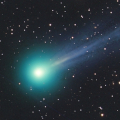
|
Now it is 6.5 mag (Oct. 4, Virgilio Gonano). It brightens up to 4 mag, but it will turn to fade out rapidly after that. In the Northern Hemisphere, it will be getting lower gradually after this, and it will be unobservable in November. In the Southern Hemisphere, it is not observable now, but it will appear in December.
Date(TT) R.A. (2000) Decl. Delta r Elong. m1 Best Time(A, h)
Oct. 4 9 59.85 40 58.3 0.948 0.946 58 6.6 4:33 (242, 37)
Oct. 11 11 20.23 42 20.7 0.743 0.832 54 5.6 4:38 (237, 29)
|
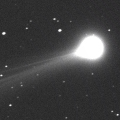
|
Bright new comet. Now it is 6.2 mag (Sept. 26, Marco Goiato). It will fade out rapidly after this. It will be getting higher gradually.
Date(TT) R.A. (2000) Decl. Delta r Elong. m1 Best Time(A, h)
Oct. 4 15 5.65 -15 43.6 0.436 0.708 37 6.7 19:03 ( 66, 5)
Oct. 11 16 20.15 -16 36.0 0.324 0.821 48 6.7 18:54 ( 56, 15)
|

|
It brightened up to 10.6 mag until mid September (Sept. 16, Thomas Lehmann). It will turn to fade out rapidly after the peak. Now it is not observable. It will be observable soon.
Date(TT) R.A. (2000) Decl. Delta r Elong. m1 Best Time(A, h)
Oct. 4 12 54.60 -13 50.3 1.295 0.359 10 7.8 19:03 ( 87,-21)
Oct. 11 12 25.61 -11 15.1 1.271 0.343 10 7.6 4:38 (275,-13)
|
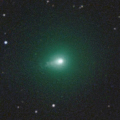
|
Third interstellar object in history following 1I/'Oumuamua and 2I/Borisov. The eccentricity is extremely big as 6. It approaches to Sun down to 1.38 a.u. in late October. Now it is 11.8 mag (Sept. 24, Michael Jager). It brightens up to 11 mag, but it will turn to fade out rapidly after that. In the Northern Hemisphere, it is not observable now, but it will appear in November. In the Southern Hemisphere, it will be unobservable soon. But it will be observable again in November.
Date(TT) R.A. (2000) Decl. Delta r Elong. m1 Best Time(A, h)
Oct. 4 14 19.70 -10 31.5 2.488 1.645 25 12.1 19:03 ( 78, -1)
Oct. 11 14 6.32 -9 37.8 2.454 1.515 15 11.8 18:54 ( 83, -7)
|
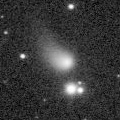
|
It is expected to brighten up to 5 mag in January. Now it is 13.1 mag (Sept. 21, Seiichi Yoshida). It will brighten rapidly after this. It will be unobservable soon in the Southern Hemisphere, or in December in the Northern Hemisphere. But it will be observable again in January in the Southern Hemisphere.
Date(TT) R.A. (2000) Decl. Delta r Elong. m1 Best Time(A, h)
Oct. 4 16 14.06 21 39.4 2.426 2.087 58 12.1 19:03 ( 90, 40)
Oct. 11 16 21.09 18 20.0 2.390 1.985 54 11.9 18:54 ( 88, 36)
|
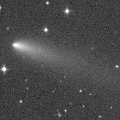
|
Now it is brighter than originally expected. Now it is 13.1 mag (Sept. 30, Hiroshi Abe). It stays 13 mag for a while. It stays observable in good condition. It is expected to brighten up to 12 mag and to be observable in good condition from autumn to winter.
Date(TT) R.A. (2000) Decl. Delta r Elong. m1 Best Time(A, h)
Oct. 4 4 15.69 -0 6.6 1.467 2.206 125 12.8 3:26 ( 0, 55)
Oct. 11 4 16.17 0 19.2 1.396 2.192 131 12.6 2:59 ( 0, 55)
|
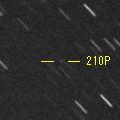
|
It is expected to brighten up to 8 mag from late autumn to early winter. Now it is 16.3 mag (Oct. 2, ATLAS Chile). It brightens up to 8.5 mag, but it will turn to fade out rapidly after that. It will be unobservable soon in the Northern Hemisphere, or in November in the Southern Hemisphere. But it will be observable again in November in the Northern Hemisphere, or in December in the Southern Hemisphere. It is much fainter than this ephemeris recently.
Date(TT) R.A. (2000) Decl. Delta r Elong. m1 Best Time(A, h)
Oct. 4 18 20.88 -41 56.4 0.567 1.095 83 13.4 19:03 ( 18, 10)
Oct. 11 18 1.68 -41 41.6 0.544 0.993 73 12.6 18:54 ( 24, 7)
|
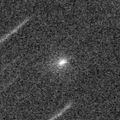
|
It brightened very rapidly. Now it is 14.4 mag (Sept. 17, Ken-ichi Kadota). It will fade out rapidly after this. It will be fainter than 18 mag in November. It will never be observable after this.
Date(TT) R.A. (2000) Decl. Delta r Elong. m1 Best Time(A, h)
Oct. 4 11 16.74 -3 44.1 1.358 0.549 20 13.0 4:33 (274, -1)
Oct. 11 11 52.90 -9 15.3 1.475 0.608 17 14.4 4:38 (278, -4)
|
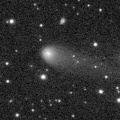
|
Now it is 13.9 mag (Sept. 23, Osamu Miyazaki). It stays 14 mag for a while. In the Northern Hemisphere, it stays observable in good condition. It locates somewhat low in the Southern Hemisphere.
Date(TT) R.A. (2000) Decl. Delta r Elong. m1 Best Time(A, h)
Oct. 4 3 36.28 26 21.1 3.123 3.867 132 13.3 2:47 ( 0, 81)
Oct. 11 3 35.71 26 28.5 3.066 3.876 139 13.3 2:19 ( 0, 82)
|
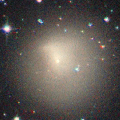
|
In the Northern Hemisphere, it will be getting higher gradually. In the Southern Hemisphere, it is not observable now, but it will be observable soon.
Date(TT) R.A. (2000) Decl. Delta r Elong. m1 Best Time(A, h)
Oct. 4 10 59.54 2 7.5 7.183 6.297 25 14.3 4:33 (272, 6)
Oct. 11 11 3.88 1 34.7 7.129 6.298 31 14.3 4:38 (276, 12)
|
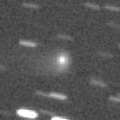
|
It is expected to brighten up to 13 mag in early summer in 2026. Now it is 14.4 mag (Sept. 12, Andrew Pearce). It stays 14 mag for a while. It will be getting lower gradually after this, and it will be unobservable in January in the Northern Hemisphere, or in November in the Southern Hemisphere. But it will be observable again in January in the Northern Hemisphere.
Date(TT) R.A. (2000) Decl. Delta r Elong. m1 Best Time(A, h)
Oct. 4 19 29.97 10 52.8 3.616 3.967 103 14.3 19:03 ( 16, 65)
Oct. 11 19 24.49 9 14.9 3.710 3.940 95 14.3 18:54 ( 27, 62)
|

|
Now it is 14.6 mag (Sept. 7, Ken-ichi Kadota). It stays 15 mag for a while. It will be unobservable soon in the Southern Hemisphere, or in November in the Northern Hemisphere. But it will be observable again in January in the Southern Hemisphere, or in December in the Northern Hemisphere.
Date(TT) R.A. (2000) Decl. Delta r Elong. m1 Best Time(A, h)
Oct. 4 15 39.88 -1 5.4 6.458 5.797 45 14.4 19:03 ( 73, 20)
Oct. 11 15 44.93 -1 9.8 6.549 5.824 40 14.5 18:54 ( 75, 18)
|
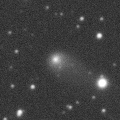
|
Now it is 15.7 mag (Sept. 19, Francois Kugel). It stays 15 mag for a while. In the Northern Hemisphere, it stays observable in good condition. It locates somewhat low in the Southern Hemisphere.
Date(TT) R.A. (2000) Decl. Delta r Elong. m1 Best Time(A, h)
Oct. 4 8 57.18 18 58.3 5.921 5.479 59 14.7 4:33 (274, 40)
Oct. 11 9 2.16 19 6.0 5.825 5.480 65 14.7 4:38 (279, 46)
|
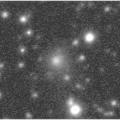
|
It will brighten up to 13 mag in 2026. Now it is 15.3 mag (Sept. 30, Alfons Diepvens). It stays 15 mag for a while. It will be getting lower gradually after this, and it will be unobservable in January in the Northern Hemisphere, or in November in the Southern Hemisphere. But it will be observable again in January in the Northern Hemisphere.
Date(TT) R.A. (2000) Decl. Delta r Elong. m1 Best Time(A, h)
Oct. 4 18 31.29 -11 6.3 5.196 5.244 87 15.0 19:03 ( 27, 40)
Oct. 11 18 32.13 -10 41.3 5.273 5.206 80 15.0 18:54 ( 33, 38)
|
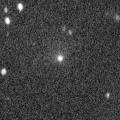
|
Very large comet. It is expected to brighten up to 13 mag in 2031. Now it is 15.3 mag (Sept. 29, Andrew Pearce). It stays 15 mag for a while. In the Northern Hemisphere, it is not observable now. In the Southern Hemisphere, it stays observable in good condition. In the Northern Hemisphere, it is not observable until 2030.
Date(TT) R.A. (2000) Decl. Delta r Elong. m1 Best Time(A, h)
Oct. 4 5 42.76 -71 51.2 14.641 14.681 90 15.0 4:33 (359,-17)
Oct. 11 5 42.73 -72 20.1 14.633 14.659 89 15.0 4:23 ( 0,-17)
|

|
Now it is 16.3 mag (Sept. 28, Alfons Diepvens). It stays 15 mag for a while. In the Northern Hemisphere, it will be getting higher gradually. It locates somewhat low in the Southern Hemisphere. But it will become high in winter.
Date(TT) R.A. (2000) Decl. Delta r Elong. m1 Best Time(A, h)
Oct. 4 9 33.80 7 22.9 3.043 2.482 47 15.0 4:33 (280, 26)
Oct. 11 9 45.05 6 7.1 2.988 2.492 51 15.0 4:38 (285, 30)
|
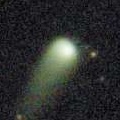
|
It was observed at 12-13 mag for a long time in 2024. Now it is 15.3 mag (Sept. 23, ATLAS-MLO, Mauna Loa). Fading slowly. In the Northern Hemisphere, it stays observable in good condition. In the Southern Hemisphere, it will be unobservable in December.
Date(TT) R.A. (2000) Decl. Delta r Elong. m1 Best Time(A, h)
Oct. 4 23 20.04 52 23.3 4.278 4.970 129 15.1 22:26 (180, 73)
Oct. 11 23 8.20 50 44.2 4.310 5.009 129 15.1 21:47 (180, 74)
|

|
Now it is 17.7 mag (July 24, Thomas Lehmann). It will brighten rapidly after this. Now it is not observable. It will appear in January in the Southern Hemisphere, or in December in the Northern Hemisphere.
Date(TT) R.A. (2000) Decl. Delta r Elong. m1 Best Time(A, h)
Oct. 4 13 8.78 -5 25.3 3.139 2.151 7 15.4 19:03 ( 92,-13)
Oct. 11 13 22.31 -6 54.5 3.098 2.104 4 15.2 18:54 ( 91,-15)
|
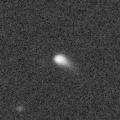
|
Now it is 15.1 mag (Oct. 2, ATLAS Chile). It stays 15 mag for a while. It stays extremely low in the Northern Hemisphere. But it will become high in autumn. In the Southern Hemisphere, it stays observable in good condition. It is expected to brighten up to 12 mag in winter between 2026 and 2027.
Date(TT) R.A. (2000) Decl. Delta r Elong. m1 Best Time(A, h)
Oct. 4 3 19.55 -44 59.3 5.624 6.174 119 15.6 2:29 ( 0, 10)
Oct. 11 3 16.72 -45 26.1 5.572 6.132 119 15.6 1:59 ( 0, 10)
|
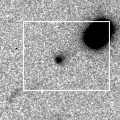
|
It is expected to brighten up to 13.5 mag and to be observable in good condition in 2026 spring. Now it is 16.8 mag (Aug. 12, ATLAS South Africa). Brightening slowly. In the Northern Hemisphere, it is not observable now, but it will appear in January. It locates somewhat low in the Southern Hemisphere. But it will become high in winter.
Date(TT) R.A. (2000) Decl. Delta r Elong. m1 Best Time(A, h)
Oct. 4 13 12.22 -61 35.6 2.488 2.129 57 15.8 19:03 ( 35,-35)
Oct. 11 13 33.61 -59 16.1 2.524 2.076 52 15.7 18:54 ( 38,-34)
|

|
Now it is 15.0 mag (Sept. 15, Purple Mountain Observatory, XuYi Station). Fading slowly. It stays observable in good condition.
Date(TT) R.A. (2000) Decl. Delta r Elong. m1 Best Time(A, h)
Oct. 4 22 43.37 -10 53.7 1.916 2.811 147 15.9 21:50 ( 0, 44)
Oct. 11 22 40.47 -10 31.5 1.970 2.809 140 15.9 21:20 ( 0, 45)
|

|
It brightened up to 12.7 mag in 2024 summer (Aug. 7, 2024, Thomas Lehmann). Now it is 15.7 mag (Sept. 23, ATLAS-MLO, Mauna Loa). Fading slowly. In the Northern Hemisphere, it stays observable in good condition. In the Southern Hemisphere, it will never be observable after this.
Date(TT) R.A. (2000) Decl. Delta r Elong. m1 Best Time(A, h)
Oct. 4 22 28.75 57 43.9 3.517 4.118 120 16.0 21:35 (180, 67)
Oct. 11 22 23.63 57 4.6 3.573 4.173 120 16.0 21:02 (180, 68)
|
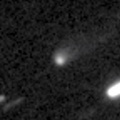
|
Now it is 15.7 mag (Sept. 14, J. Tapioles). It stays 17 mag for a while. It will be unobservable in January.
Date(TT) R.A. (2000) Decl. Delta r Elong. m1 Best Time(A, h)
Oct. 4 18 43.17 -31 13.8 2.827 2.977 88 16.0 19:03 ( 17, 22)
Oct. 11 18 50.97 -30 57.6 2.926 2.983 83 16.1 18:54 ( 19, 21)
|

|
It will brighten up to 12 mag in 2026 summer. Now it is 16.2 mag (Sept. 18, Francois Kugel). Brightening slowly. In the Northern Hemisphere, it stays observable in good condition. In the Southern Hemisphere, it will be getting lower gradually after this, and it will be unobservable in January.
Date(TT) R.A. (2000) Decl. Delta r Elong. m1 Best Time(A, h)
Oct. 4 19 53.50 -13 36.4 2.379 2.837 106 16.1 19:03 ( 1, 41)
Oct. 11 19 56.67 -13 46.6 2.440 2.804 100 16.0 18:54 ( 6, 41)
|
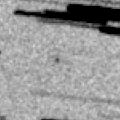
|
It will brighten up to 8 mag in winter, and will be observable in good condition. Now it is 17.6 mag (Sept. 29, Katsumi Yoshimoto). Brightening rapidly. In the Northern Hemisphere, it stays observable in good condition. It locates somewhat low in the Southern Hemisphere. But it will become high in winter.
Date(TT) R.A. (2000) Decl. Delta r Elong. m1 Best Time(A, h)
Oct. 4 6 38.16 19 13.1 1.341 1.696 91 16.5 4:33 (309, 67)
Oct. 11 6 58.46 19 32.2 1.235 1.639 93 16.1 4:38 (314, 69)
|
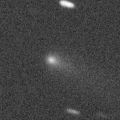
|
It brightened up to 12.1 mag in early summer (June 10, Taras Prystavski). Now it is 15.2 mag (Oct. 2, C. Gerhard). Fading slowly. It will be fainter than 18 mag in January. In the Northern Hemisphere, it stays observable in good condition. In the Southern Hemisphere, it will be getting higher gradually.
Date(TT) R.A. (2000) Decl. Delta r Elong. m1 Best Time(A, h)
Oct. 4 8 30.87 13 40.8 2.213 1.992 64 16.2 4:33 (285, 43)
Oct. 11 8 40.95 13 18.9 2.192 2.049 68 16.4 4:38 (290, 47)
|

|
Now it is 17.0 mag (Sept. 23, ATLAS-HKO, Haleakala). It stays 16 mag for a while. In the Northern Hemisphere, it stays observable in good condition. In the Southern Hemisphere, it will be unobservable in January.
Date(TT) R.A. (2000) Decl. Delta r Elong. m1 Best Time(A, h)
Oct. 4 8 41.87 31 9.0 4.288 3.997 66 16.4 4:33 (261, 48)
Oct. 11 8 45.92 32 27.1 4.190 4.012 72 16.3 4:38 (262, 55)
|

|
Now it is 16.6 mag (Oct. 2, ATLAS-MLO, Mauna Loa). It stays 16 mag for a while. In the Northern Hemisphere, it will be getting higher gradually. In the Southern Hemisphere, it stays observable in good condition.
Date(TT) R.A. (2000) Decl. Delta r Elong. m1 Best Time(A, h)
Oct. 4 8 43.69 -10 60.0 7.035 6.571 58 16.4 4:33 (305, 24)
Oct. 11 8 46.98 -11 11.8 6.954 6.573 63 16.4 4:38 (311, 29)
|

|
Now it is 16.0 mag (Sept. 12, Alfons Diepvens). It stays 17 mag for a while. In the Northern Hemisphere, it stays observable in good condition. In the Southern Hemisphere, it will never be observable after this.
Date(TT) R.A. (2000) Decl. Delta r Elong. m1 Best Time(A, h)
Oct. 4 13 50.57 63 13.0 4.647 4.385 68 16.5 19:03 (148, 30)
Oct. 11 14 9.53 63 17.0 4.614 4.396 71 16.5 18:54 (148, 30)
|

|
It brightened very rapidly, and it became brighter than expected. Now it is 15.8 mag (Sept. 27, Katsumi Yoshimoto). Fading slowly. It will be fainter than 18 mag in January. It stays observable in good condition.
Date(TT) R.A. (2000) Decl. Delta r Elong. m1 Best Time(A, h)
Oct. 4 0 34.76 -4 42.3 2.427 3.419 171 16.5 23:41 ( 0, 50)
Oct. 11 0 30.64 -5 9.5 2.452 3.427 165 16.6 23:09 ( 0, 50)
|
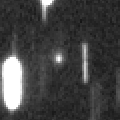
|
Now it is 16.7 mag (Sept. 18, Francois Kugel). It stays 17 mag for a while. In the Northern Hemisphere, it stays observable in good condition. In the Southern Hemisphere, it will be getting lower gradually after this, and it will be unobservable in January.
Date(TT) R.A. (2000) Decl. Delta r Elong. m1 Best Time(A, h)
Oct. 4 19 56.10 -16 11.5 1.596 2.119 107 16.6 19:04 ( 0, 39)
Oct. 11 20 3.13 -15 45.0 1.655 2.103 102 16.6 18:54 ( 3, 39)
|
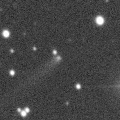
|
Now it is 16.9 mag (July 13, Taras Prystavski). It stays 17 mag for a while. In the Northern Hemisphere, it is not observable now, but it will be observable soon. In the Southern Hemisphere, it will be getting higher gradually.
Date(TT) R.A. (2000) Decl. Delta r Elong. m1 Best Time(A, h)
Oct. 4 10 58.93 -22 24.5 6.345 5.504 30 16.9 4:33 (292, -8)
Oct. 11 11 0.44 -22 36.2 6.324 5.522 33 16.9 4:38 (296, -2)
|
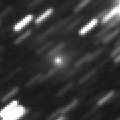
|
Very far object. Now it is 17.4 mag (July 26, ATLAS South Africa). It stays 17 mag for a while. In the Northern Hemisphere, it is not observable now, but it will appear in November. In the Southern Hemisphere, it stays observable in good condition.
Date(TT) R.A. (2000) Decl. Delta r Elong. m1 Best Time(A, h)
Oct. 4 0 44.36 -57 40.3 10.438 10.945 118 17.0 23:50 ( 0, -3)
Oct. 11 0 38.85 -57 30.6 10.492 10.957 115 17.0 23:17 ( 0, -2)
|

|
Now it is 16.9 mag (Sept. 28, Alfons Diepvens). It stays 17 mag for a while. In the Northern Hemisphere, it stays observable in good condition. It stays extremely low in the Southern Hemisphere.
Date(TT) R.A. (2000) Decl. Delta r Elong. m1 Best Time(A, h)
Oct. 4 5 13.51 48 2.2 3.454 3.872 107 17.1 4:24 (180, 77)
Oct. 11 5 15.59 48 56.6 3.366 3.866 112 17.0 3:58 (180, 76)
|
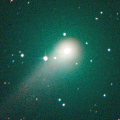
|
It was observed at 9-10 mag for a long time in 2023. It is fading very slowly. Now it is 16.6 mag (Sept. 14, ATLAS Chile). It stays 17 mag for a while. In the Northern Hemisphere, it will never be observable after this. In the Southern Hemisphere, it stays observable in good condition.
Date(TT) R.A. (2000) Decl. Delta r Elong. m1 Best Time(A, h)
Oct. 4 18 54.88 -70 31.7 8.422 8.435 87 17.0 19:03 ( 5,-16)
Oct. 11 18 53.45 -69 53.2 8.557 8.485 82 17.1 18:54 ( 7,-16)
|

|
Now it is 16.9 mag (Oct. 3, ATLAS-MLO, Mauna Loa). It stays 17 mag for a while. In the Northern Hemisphere, it stays observable in good condition. In the Southern Hemisphere, it will never be observable after this.
Date(TT) R.A. (2000) Decl. Delta r Elong. m1 Best Time(A, h)
Oct. 4 8 5.18 75 44.4 5.050 5.130 88 17.0 4:33 (193, 45)
Oct. 11 8 24.34 77 13.7 4.983 5.124 92 17.0 4:38 (191, 45)
|
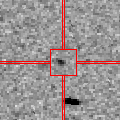
|
Now it is 17.3 mag (Oct. 1, ATLAS-MLO, Mauna Loa). It stays 17 mag for a while. It stays observable in good condition.
Date(TT) R.A. (2000) Decl. Delta r Elong. m1 Best Time(A, h)
Oct. 4 22 19.63 -23 16.6 1.341 2.176 136 17.1 21:27 ( 0, 32)
Oct. 11 22 17.55 -22 23.1 1.367 2.147 129 17.0 20:57 ( 0, 33)
|
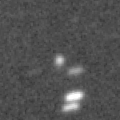
|
Brightening rapidly. It is expected to brighten up to 13 mag from 2027 to 2028. Now it is 16.2 mag (Sept. 23, Andrew Pearce). It stays 17 mag for a while. In the Northern Hemisphere, it stays observable in good condition. In the Southern Hemisphere, it will be getting lower gradually after this, and it will be unobservable in December.
Date(TT) R.A. (2000) Decl. Delta r Elong. m1 Best Time(A, h)
Oct. 4 21 44.51 23 23.9 6.589 7.316 133 17.1 20:51 ( 0, 78)
Oct. 11 21 40.70 23 6.0 6.613 7.276 128 17.0 20:20 ( 0, 78)
|
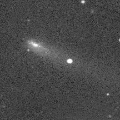
|
Now it is 15.8 mag (Oct. 3, ATLAS Chile). Fading slowly. It will be fainter than 18 mag in November. It stays observable in good condition.
Date(TT) R.A. (2000) Decl. Delta r Elong. m1 Best Time(A, h)
Oct. 4 4 1.81 4 9.6 1.817 2.571 129 17.2 3:12 ( 0, 59)
Oct. 11 3 59.57 3 45.7 1.785 2.601 136 17.3 2:42 ( 0, 59)
|
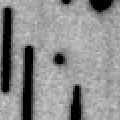
|
Now it is 17.5 mag (Sept. 23, Ken-ichi Kadota). Fading slowly. It will be fainter than 18 mag in December. In the Northern Hemisphere, it stays observable in good condition. In the Southern Hemisphere, it will never be observable after this.
Date(TT) R.A. (2000) Decl. Delta r Elong. m1 Best Time(A, h)
Oct. 4 22 24.68 85 24.6 1.670 2.063 98 17.3 21:04 (180, 40)
Oct. 11 19 31.48 79 41.1 1.646 2.040 97 17.2 18:54 (177, 45)
|

|
Now it is 17.7 mag (Sept. 18, Hidetaka Sato). It stays 17 mag for a while. It locates somewhat low in the Northern Hemisphere. In the Southern Hemisphere, it will be getting higher gradually.
Date(TT) R.A. (2000) Decl. Delta r Elong. m1 Best Time(A, h)
Oct. 4 9 20.11 -17 7.0 5.019 4.449 50 17.2 4:33 (302, 13)
Oct. 11 9 25.97 -18 14.6 4.958 4.451 54 17.2 4:38 (308, 17)
|
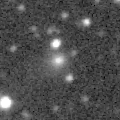
|
Now it is 17.0 mag (Sept. 25, ATLAS-MLO, Mauna Loa). Fading slowly. It will be fainter than 18 mag in December. In the Northern Hemisphere, it stays observable in good condition. In the Southern Hemisphere, it will be getting lower gradually.
Date(TT) R.A. (2000) Decl. Delta r Elong. m1 Best Time(A, h)
Oct. 4 19 48.03 -14 51.9 4.736 5.095 105 17.2 19:03 ( 2, 40)
Oct. 11 19 50.10 -14 36.4 4.868 5.122 99 17.3 18:54 ( 8, 40)
|

|
Now it is 17.1 mag (Sept. 28, Alfons Diepvens). It stays 17 mag for a while. In the Northern Hemisphere, it stays observable in good condition. It stays extremely low in the Southern Hemisphere.
Date(TT) R.A. (2000) Decl. Delta r Elong. m1 Best Time(A, h)
Oct. 4 9 33.15 21 15.3 2.528 2.072 52 17.3 4:33 (267, 34)
Oct. 11 9 47.02 20 53.2 2.499 2.109 55 17.3 4:38 (270, 38)
|
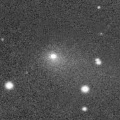
|
It brightened rapidly up to 14.6 mag in winter (Jan. 31, Thomas Lehmann). Now it is 17.1 mag (Sept. 22, ATLAS South Africa). Fading gradually. It will be fainter than 18 mag in November. It stays extremely low in the Northern Hemisphere. In the Southern Hemisphere, it stays observable in good condition.
Date(TT) R.A. (2000) Decl. Delta r Elong. m1 Best Time(A, h)
Oct. 4 3 7.32 -42 15.8 2.330 2.991 122 17.3 2:17 ( 0, 13)
Oct. 11 3 0.12 -44 51.3 2.402 3.052 122 17.5 1:43 ( 0, 10)
|
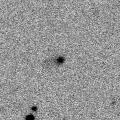
|
It continues brightening even after the perihelion passage. Now it is 17.0 mag (Sept. 23, ATLAS Chile). It stays 18 mag for a while. In the Northern Hemisphere, it will never be observable after this. In the Southern Hemisphere, it stays observable in good condition.
Date(TT) R.A. (2000) Decl. Delta r Elong. m1 Best Time(A, h)
Oct. 4 1 26.77 -68 49.5 5.299 5.664 106 17.3 0:38 ( 0,-14)
Oct. 11 1 5.54 -68 55.9 5.362 5.690 104 17.3 23:42 ( 0,-14)
|
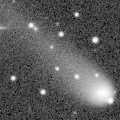
|
Now it is 17.1 mag (Sept. 2, Andrew Pearce). It stays 18 mag for a while. It stays extremely low in the Northern Hemisphere. In the Southern Hemisphere, it stays observable in good condition.
Date(TT) R.A. (2000) Decl. Delta r Elong. m1 Best Time(A, h)
Oct. 4 5 55.55 -43 53.6 8.144 8.289 94 17.3 4:33 (354, 11)
Oct. 11 5 52.49 -44 37.2 8.140 8.333 97 17.4 4:34 ( 0, 10)
|
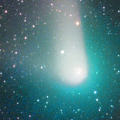
|
It brightened up to 8 mag from 2022 summer to 2023 spring. Now it is 17.2 mag (Sept. 28, Alfons Diepvens). It stays 18 mag for a while. In the Northern Hemisphere, it stays observable in good condition. It locates somewhat low in the Southern Hemisphere.
Date(TT) R.A. (2000) Decl. Delta r Elong. m1 Best Time(A, h)
Oct. 4 6 19.85 28 31.3 9.511 9.672 96 17.3 4:33 (294, 76)
Oct. 11 6 19.15 28 44.0 9.443 9.721 103 17.4 4:38 (320, 82)
|
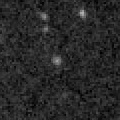
|
Now it is 17.7 mag (Aug. 30, J. Linder). Brightening slowly. In the Northern Hemisphere, it stays observable in good condition. In the Southern Hemisphere, it is not observable now.
Date(TT) R.A. (2000) Decl. Delta r Elong. m1 Best Time(A, h)
Oct. 4 11 8.53 69 41.3 4.363 4.225 75 17.5 4:33 (205, 34)
Oct. 11 11 12.64 69 47.7 4.266 4.193 79 17.4 4:38 (205, 36)
|

|
It brightened up to -3 mag due to the forward scattering in the SOHO coronagraph images (Oct. 9, 2024, Q.-c. Zhang, Charles S. Morris). It became a great comet of 0 mag on the ground. Now it is 17.2 mag (Sept. 21, D. Buczynski). Fading slowly. It will be fainter than 18 mag soon. In the Northern Hemisphere, it will be getting lower gradually. It locates somewhat low in the Southern Hemisphere.
Date(TT) R.A. (2000) Decl. Delta r Elong. m1 Best Time(A, h)
Oct. 4 17 54.70 16 26.4 5.392 5.320 80 17.5 19:03 ( 63, 57)
Oct. 11 17 55.89 15 38.4 5.554 5.391 75 17.7 18:54 ( 67, 53)
|
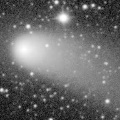
|
It brightened up to 9.6 mag from February to March in 2024 (Feb. 25, 2024, Thomas Lehmann). Now it is 17.9 mag (Sept. 17, Ken-ichi Kadota). Fading slowly. It will be fainter than 18 mag in November. In the Northern Hemisphere, it stays observable in good condition. It stays extremely low in the Southern Hemisphere.
Date(TT) R.A. (2000) Decl. Delta r Elong. m1 Best Time(A, h)
Oct. 4 22 59.05 41 42.5 5.972 6.731 136 17.7 22:06 (180, 83)
Oct. 11 22 55.88 40 53.3 6.041 6.790 135 17.7 21:35 (180, 84)
|
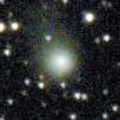
|
It brightened up to 12.1 mag in 2023 spring (May 20, 2023, Jose Guilherme de S. Aguiar). Now it is 17.4 mag (Mar. 25, ATLAS South Africa). It stays 18 mag for a while. It stays observable in good condition.
Date(TT) R.A. (2000) Decl. Delta r Elong. m1 Best Time(A, h)
Oct. 4 6 42.50 -19 8.5 8.100 8.124 87 17.7 4:33 (338, 33)
Oct. 11 6 41.99 -19 26.8 8.057 8.171 93 17.7 4:38 (347, 34)
|

|
Now it is 17.7 mag (June 26, ATLAS Chile). It stays 18 mag for a while. It will be getting higher gradually.
Date(TT) R.A. (2000) Decl. Delta r Elong. m1 Best Time(A, h)
Oct. 4 9 18.10 -7 36.4 4.316 3.754 50 17.7 4:33 (296, 20)
Oct. 11 9 20.70 -7 14.8 4.240 3.767 55 17.7 4:38 (301, 26)
|
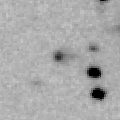
|
Now it is 17.8 mag (Sept. 21, Alfons Diepvens). It stays 18 mag for a while. It will be unobservable in November in the Southern Hemisphere, or in December in the Northern Hemisphere. But it will be observable again in January in the Northern Hemisphere.
Date(TT) R.A. (2000) Decl. Delta r Elong. m1 Best Time(A, h)
Oct. 4 17 6.65 6 8.7 5.368 5.071 67 17.7 19:03 ( 63, 42)
Oct. 11 17 11.89 5 22.4 5.435 5.058 62 17.7 18:54 ( 65, 39)
|
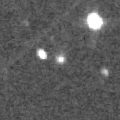
|
Now it is 17.5 mag (Sept. 23, ATLAS-MLO, Mauna Loa). It stays 18 mag for a while. In the Northern Hemisphere, it will be getting lower gradually. In the Southern Hemisphere, it will never be observable after this.
Date(TT) R.A. (2000) Decl. Delta r Elong. m1 Best Time(A, h)
Oct. 4 16 40.43 44 58.8 5.401 5.192 72 17.7 19:03 (120, 52)
Oct. 11 16 44.96 43 12.7 5.452 5.206 70 17.8 18:54 (118, 49)
|
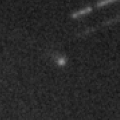
|
Now it is 17.6 mag (Sept. 29, ATLAS Chile). It stays 18 mag for a while. In the Northern Hemisphere, it will never be observable after this. In the Southern Hemisphere, it stays observable in good condition.
Date(TT) R.A. (2000) Decl. Delta r Elong. m1 Best Time(A, h)
Oct. 4 20 27.34 -55 42.5 2.578 2.941 101 17.7 19:35 ( 0, -1)
Oct. 11 20 22.83 -56 31.6 2.666 2.923 94 17.8 19:03 ( 0, -1)
|
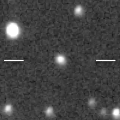
|
Although it is around 20 mag usually, now it is bright in outburst. Now it is 17.2 mag (Sept. 30, ATLAS-MLO, Mauna Loa). It stays 18 mag for a while. In the Northern Hemisphere, it stays observable in good condition. It stays extremely low in the Southern Hemisphere.
Date(TT) R.A. (2000) Decl. Delta r Elong. m1 Best Time(A, h)
Oct. 4 3 11.82 38 18.0 8.205 8.899 131 17.8 2:22 (180, 87)
Oct. 11 3 9.88 38 25.5 8.125 8.889 137 17.8 1:53 (180, 86)
|

|
Now it is 17.8 mag (Mar. 17, ATLAS Chile). It stays 18 mag for a while. It stays observable in good condition.
Date(TT) R.A. (2000) Decl. Delta r Elong. m1 Best Time(A, h)
Oct. 4 7 49.90 -9 19.2 4.376 4.175 71 17.9 4:33 (315, 34)
Oct. 11 7 54.37 -10 5.9 4.300 4.184 76 17.8 4:38 (323, 37)
|

|
Now it is 18.1 mag (Sept. 17, ATLAS-HKO, Haleakala). It stays 18 mag for a while. It stays observable in good condition.
Date(TT) R.A. (2000) Decl. Delta r Elong. m1 Best Time(A, h)
Oct. 4 7 1.18 9 37.7 4.076 4.117 85 17.9 4:33 (313, 56)
Oct. 11 7 4.55 9 4.6 3.984 4.127 91 17.9 4:38 (325, 60)
|
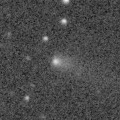
|
Now it is 16.5 mag (Oct. 3, ATLAS Chile). Fading gradually. It will be fainter than 18 mag soon. It stays observable in good condition.
Date(TT) R.A. (2000) Decl. Delta r Elong. m1 Best Time(A, h)
Oct. 4 0 21.58 4 20.0 1.609 2.608 175 17.9 23:28 ( 0, 59)
Oct. 11 0 17.06 3 42.9 1.644 2.628 167 18.0 22:56 ( 0, 59)
|

|
It brightened up to 11 mag in the SWAN images in early spring (Jan. 27, Vladimir Bezugly). Now it is fainter than 19.5 mag (Oct. 2, Martin Masek). It stays 18 mag for a while. It will be getting higher gradually.
Date(TT) R.A. (2000) Decl. Delta r Elong. m1 Best Time(A, h)
Oct. 4 9 20.48 -10 17.2 3.029 2.500 49 17.9 4:33 (297, 18)
Oct. 11 9 28.57 -11 28.0 3.023 2.558 53 18.0 4:38 (303, 22)
|
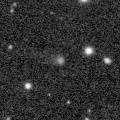
|
Now it is 18.1 mag (Sept. 22, Francois Kugel). It stays 18 mag for a while. In the Northern Hemisphere, it will be getting lower gradually. In the Southern Hemisphere, it will never be observable after this.
Date(TT) R.A. (2000) Decl. Delta r Elong. m1 Best Time(A, h)
Oct. 4 15 25.13 39 40.8 5.589 5.132 58 17.9 19:03 (116, 37)
Oct. 11 15 27.13 38 23.4 5.629 5.138 56 18.0 18:54 (116, 34)
|
|
![]()
 C/2024 J2 ( Wierzchos )
C/2024 J2 ( Wierzchos ) C/2023 U1 ( Fuls )
C/2023 U1 ( Fuls ) C/2019 U5 ( PanSTARRS )
C/2019 U5 ( PanSTARRS ) C/2017 K2 ( PanSTARRS )
C/2017 K2 ( PanSTARRS ) C/2025 J1 ( Borisov )
C/2025 J1 ( Borisov ) C/2023 A3 ( Tsuchinshan-ATLAS )
C/2023 A3 ( Tsuchinshan-ATLAS ) C/2021 S3 ( PanSTARRS )
C/2021 S3 ( PanSTARRS ) C/2020 K1 ( PanSTARRS )
C/2020 K1 ( PanSTARRS ) C/2024 X2 ( ATLAS )
C/2024 X2 ( ATLAS ) C/2024 G4 ( PanSTARRS )
C/2024 G4 ( PanSTARRS ) C/2024 N3 ( Sarneczky )
C/2024 N3 ( Sarneczky ) C/2025 L2 ( MAPS )
C/2025 L2 ( MAPS ) C/2023 RS61 ( PanSTARRS )
C/2023 RS61 ( PanSTARRS ) 242P/Spahr
242P/Spahr 276P/Vorobjov
276P/Vorobjov 486P/2024 H1 ( Leonard )
486P/2024 H1 ( Leonard ) 21P/Giacobini-Zinner
21P/Giacobini-Zinner C/2023 V1 ( Lemmon )
C/2023 V1 ( Lemmon )![]()


























































